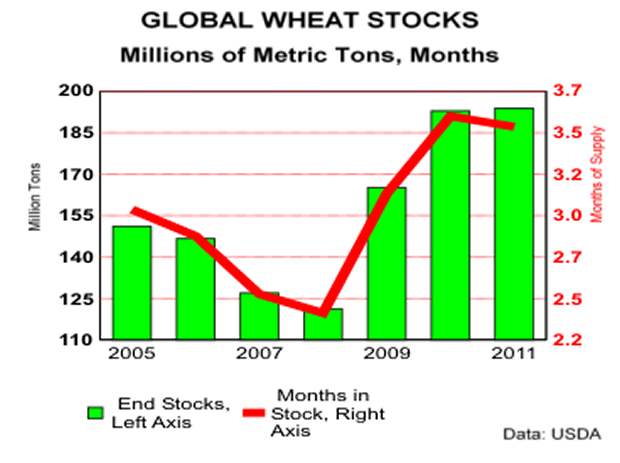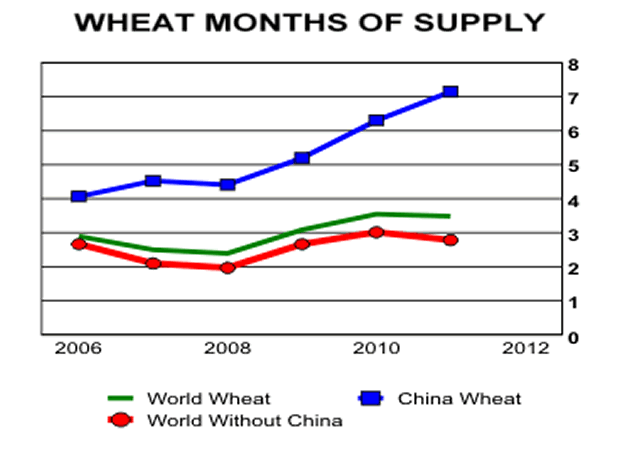Gulf Oil Spill Could Spark Agri-Food's Wheat Commodity Ethanol Demand
Commodities / Agricultural Commodities Jun 13, 2010 - 01:34 PM GMTBy: Ned_W_Schmidt
 Many people would feel rich with a $1,000 in their wallet. But, it might really depend where one was. In New York City or London, a thousand dollars does not go very far. However, if one was in Uruguay, that grand might be meaningful wealth. True value of what one has in hand of anything, be it money or wheat, depends on how much of it one will consume each day.
Many people would feel rich with a $1,000 in their wallet. But, it might really depend where one was. In New York City or London, a thousand dollars does not go very far. However, if one was in Uruguay, that grand might be meaningful wealth. True value of what one has in hand of anything, be it money or wheat, depends on how much of it one will consume each day.
This little lesson, which is not difficult for most to comprehend, is an extremely difficult one for grain traders. Their minds are generally unable to move beyond simple moving averages and simplistic views of inventory forecasts. Further, grain traders are mired in the grain markets of yesteryear. Today, Agri-Food commodities are operating on the price inelastic component of the long-run supply curve. That means the focus should be on demand, not on supply.

www.agrifoodvalueview.com
Above graph is of global wheat supplies in storage at the end of each crop year. We are looking at wheat cause it is the grain that traders love to hate. Listening to their opinions would make one believe that the price of wheat is going to zero. Something far different is likely.
Green bars, using left axis, are estimated end of crop year supplies of wheat in the bin. That is the amount of wheat in reserve to both keep the pipe line flowing and act as a reserve against crop uncertainties. In 2008, global wheat supplies fell to a dramatic low, which led to a rather robust move in prices. Since then, amount of wheat in storage has risen considerably due to good global crops.
However, the meaningful part of the graph is the red line, using right axis. It is how many months of wheat consumption are in storage, or reserve. In 2008, the world only had 2.4 months of wheat consumption on hand. If no wheat had been grown, in 2.4 months the world would have been out of wheat. End of crop year 2011 estimate for ending wheat stocks is about 3.5 months. Now, that is up dramatically from 2008, but it hardly represents food security for the world. If we told the public that no bread would be available after the end of September, what might consumers do?

Another quirk in such macro numbers is that they do not tell us where that wheat might be. In the above graph is a blue line, which represents the months of wheat reserves existing in China. The red line is situation for the world if Chinese wheat reserves are excluded from the calculation. If we exclude China, the world will only have about 2.8 months of wheat consumption in reserve next year. That of course assumes all works out as the USDA forecasts.
China has about seven months of wheat consumption in reserves. Why might China carry such large wheat reserves? Two motivations might exist. First, government would not like to experience a period with inadequate food supplies. Political back lash from the citizenry would be strong. Food riots are one of the last things Chinese government wants to happen. It is a giant insurance policy.
Second, many in government are young enough to remember the Great Leap Forward of 1958. Dillon(2009), in Contemporary China - An introduction, notes,
"...the manner in which the Great Leap was carried out was probably the main cause of at least twenty million deaths, over and above what would have normally have been expected, in 1959-60, three years when rural China was devastated by terrible famines. The famines were not caused solely by the Great Leap . . .but far from mitigating the effects of the famines as some claimed at the time, the transfer of farmers from agriculture to the production of iron and steel in the over-enthusiastic drive to industrialize made it more difficult to produce food crops and to share what was available.(17)"
Any interruption in wheat production would push the world to a critical shortage of wheat. And please note that wheat is grown in fields and is subject to the vagaries of Mother Nature. Wheat is not produced in a factory. In any particular region, it is harvested one time a year. Knowing that, could anything go wrong with wheat production? For example, could something as Biblical as locusts be a threat to an important wheat producing region? Wendy Pugh, "Worst Locust Plague in Two Decades Threatens Australian Harvest" at bloomberg.com on 11 June, wrote,
"The worst locust plague in more than two decades is threatening to strike Australia, the world's fourth-largest wheat exporter, after rainfall boosted egg-laying by the insects in major crop growing regions."
"The forecast plague could cost Victoria's agriculture sector A$2 billion ($1.7 billion) if left untreated, the state government said today. Widespread egg-laying across south- eastern Australia has set the scene for the biggest hatching for at least 25 years, according to the commission, which describes locusts as the nation's most serious pest species."
"'The advice of leading scientists indicates the scale of the coming spring's outbreak could be as bad as we experienced in 1973 and 1974 when locusts swarmed through much of Victoria,' state premier John Brumby said today in a statement. "'Prior to that, the last outbreak of this scale was in 1934, so we could be facing a once-in-a-lifetime locust plague with locusts swarming right across the state."'"
"The first-generation spring hatching alone could occur over a total area of 1.8 million hectares (4.4 million acres), the commission's Adriaansen said. . .High density swarms, with more than 50 insects in a square meter, can eat 20 metric tons of vegetation a day, ..."
World is going to discover in the near future the tenuous nature of the global Agri-Food balance. At the same time a big message is coming out of the Gulf of Mexico. Case for biofuels has been unequivocally validated by oil spill in Gulf of Mexico. Biofuels do not produce oil spills offshore! U.S. should move immediately, to help avoid future offshore oil spills, to raise the ethanol mandate to 12-15%. At the same time the tax credit for biodiesel should be immediately reinstated. Biodiesel does not pollute the oceans, and currently the U.S. is producing near zero biodiesel because of the loss of the tax credit.. To learn more about Agri-Food, use this link; www.agrifoodvalueview.com/RecentIssue.html
By Ned W Schmidt CFA, CEBS
AGRI-FOOD THOUGHTS is from Ned W. Schmidt,CFA,CEBS, publisher of The Agri-Food Value View, a monthly exploration of the Agri-Food grand cycle being created by China, India, and Eco-energy. To contract Ned or to learn more, use this link: www.agrifoodvalueview.com.
Copyright © 2010 Ned W. Schmidt - All Rights Reserved
Ned W Schmidt Archive |
© 2005-2022 http://www.MarketOracle.co.uk - The Market Oracle is a FREE Daily Financial Markets Analysis & Forecasting online publication.



